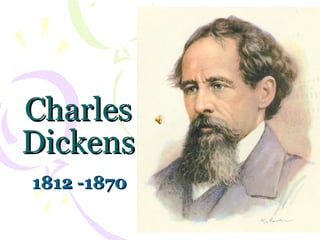This blog is in response to the task given by our professor Dilip Barad sir https://blog.dilipbarad.com/2021/02/hard-times-charles-dickens.html In this blog I am going to write about my understanding on the famous Victorian novelist Charles Dickens's novel 'Hard Times.'
CHARLES DICKENS:
Charles Dickens (Charles John Huffam Dickens) was born in Landport, Portsmouth, on February 7, 1812. Charles was the second of eight children to John Dickens (1786–1851), a clerk in the Navy Pay Office, and his wife Elizabeth Dickens (1789–1863). The Dickens family moved to London in 1814 and two years later to Chatham, Kent, where Charles spent early years of his childhood. Due to the financial difficulties they moved back to London in 1822, where they settled in Camden Town, a poor neighborhood of London.
Along with 14 novels, many of them rich in topical allusion, he produced a body of work as reporter, essayist, correspondent, and editor that constitutes a lifelong account of the facts of Victorian life as he knew them. Dickens was a lover of facts in his work as a reporter, but his non-fiction work is anything but a mere collection of data. In his reporting and commentary, Dickens is often an outraged reformer, uncompromising in his attacks on privileged interests. In the early sketches, he is a writer trying to achieve a synthesis of art and social criticism.
The surviving letters, some 14,500 of which the editors of the ongoing Pilgrim Edition have collected, reveal a man of astonishing energies, who attempted to impose an artist’s vision of order on every aspect of his life and work. In the late essays, Dickens emerges as a restless, poetic wanderer who masterfully blends observation, autobiography, and allegory. Much of this prose is valuable as a window on the novelist’s attitudes and preoccupations, but most of it stands on its own, the work of an acute observer and dedicated craftsman.
HIS FAMOUS WORK:
2. Oliver Twist. London, 1837-1839.
3. The life and adventures of Nicholas Nickleby. London, 1838-1839.
4. Christmas Carol. London, 1843.
5. David Copperfield. London, 1849-1850.
6. Bleak house. London, 1852-1853.
7.Hard Times, 1854.
8. A Tale of Two Cities. London, 1859.
9. Great Expectations. London, 1860-1861.
HARD TIMES:
Charles Dickens (1812–1870) published this ‘Condition of England’ novel in 1854. His setting was a mythical place called Coketown, partly inspired by a visit to the Northern industrial town of Preston where he had observed a strike. Dickens was motivated by social concerns: he feared that industrialization and ‘progress’ threatened to stunt human sympathies, forcing people into mechanistic social roles. He conveys what life was like in factory towns by blending documentary realism with imaginative grotesques and vivid, melodramatic elements. Thomas Gradgrind, a staunch advocate of rules and principles, has raised his children in a cold, loveless atmosphere. His Utilitarian philosophy is based upon rational self-interest. The text draws a marked contrast between Fact and Fancy – for the residents of Coketown, delight is found only in the entertainments provided by Sleary's circus.
THEMES OF HARD TIMES:
Industrialism and Its Evils
Unhappy Marriages
Femininity
Here is a hindi play of Hard Times:
Play starts with a story which is described by two characters that have no trace in the novel i.e.(sutradhar and natt) who build an outline of the story for the audience. They gave one statement like, "why such a old story". Novel is converted in to play. novel performed as Play/Drama. That's why novels all characters and dialogues both are same in Drama.
So, Novel is divided into 3 parts:
1.Sowing.
2.Reaping.
3.Garnering.
And in this play, play divided into same three parts.
1. sowing:
Novels and play started with same scene. scene of school. In this scene school master teach you should follow FACT/FACT/FACT... After that half of part is finished there is another song which is sing by play's character this song is making satire on Machines.
2.Reaping:
-In this scene we can see situation of working class people. one character Stephan Blackpool(one servant in company of Josiah Bounderby.) whole scene is based on situation of working class people.
3.Garnering:
In this last scene whole story came to end. In this scene we see that Emotional and Sentiments, vs Logic and Reasons. After this we can see a theme of urban life vs rural life. And we can see industrial revolution.
This is brief introduction of this play.. for More detail watch this play.
Here are some video lecture of Dilip sir:
*Key Facts of the novel, "Hard Times.":
1.Full Title: Hard Times : for these times
2.Author: Charles Dickens
3.Type of work: Novel
4.Genre: Naturalism vs. Realism, Agriculture society and Industrial society. Social realistic novel.
5.Language: English
6.Time and place written: periodical Household Words from April to August 1854, published in book in same year, 1854.
7.Narrator: The anonymous narrator.
8.Point of view: The narrator speaks in the third person and has a limited omniscience (the person who present everywhere and every time.)
9.Tone: The narrator's tone is drastically but it is Frequently ironical.
10.Setting(Time): The middle of the nineteenth century.(1850s)
11.Setting(Place): Coketown.(Fictional town.)
12.Protagonist: Louisa Gradgrind.
13.Rising Action: Sissy joins the Gradgrind household, and Louisa marries Mr. Bounderby unwillingly, only to satisfy her father's sense of what would be most rational for her.
14.Falling Action: Sissy informs Harthouse that Louisa will never see him again, and Louisa attempts to amend her life by appealing to her father and offering assistance to the alleged perpetrator in Bounderby's bank robbery.
15.Climax: Mr. Harthouse joins Gradgrind's political disciples and attempts to seduce Louisa. Louisa, confused, leaves Bounderby and returns to her father's house, where she collapses.
16.Symbols: Staircase, Pegasus, Smoke Serpents,
Fire.
This all are key facts of novel Hard Times. After reading this blog and after watching some videos you can read some Article which is based on the Play Hard Times.
Here I tried my best to write about this Play...
Thank you so much for reading this blog...
keep loving literature...
(Total words-1050)


No comments:
Post a Comment